Research - (2022) Volume 12, Issue 12
Dendrometric and orographic factors influencing the natural regeneration of Aleppo pine (Pinus halepensis Mill.) in semi-arid regions (Djelfa, Algeria)
B. Daoudi1*, K. Cherifi1, F.A. Belhouadjeb2 and A. Khadoumi3Abstract
The present study aims to show the effects of dendrometric and orographic factors on the natural regeneration of Aleppo pine (Pinus halepensis Mill.) in the Saharan Atlas, particularly the Senalba Chergui massif (Eastern Senalba mountain range) in Algeria, for its important forest area occupied by Aleppo pine in semi-aridregions. The sampling adopted is stratified and subjective; stratified sampling makes it possible to obtain representative stations for the various existing ecological situations, we divided our study area into 04 homogeneous stations according to the appearance of vegetation, the slope exposure and the type of the soil; and for every station, temporary observation plots are installed through subjective sampling, this method is used to study heterogeneous ecological environments; we installed in our study stations seventy (70) temporary plots, and the plot is a circular sampling unit that covers an area of 400 m2. In each plot, dendrometric variables were measured: diameter at breast height, total tree height, dominant height, average density per hectare, basal area per hectare, the age of stands, and cumulative surface of crown cover; and a phytoecological survey was carried out to determine the environmental parameters, such as altitude, slope, exposure and lithology. We used the principal component analysis (PCA) to identify the homogeneous sample plots (compared to the regeneration), descriptive statistics, and the Analysis of variance (ANOVA). The number of seedlings per square meter varies between 0 and 0.23, and there are several factors affecting these results,mainly: Crown cover, density, basal area, age of stands and slope exposure.
Keywords
Natural regeneration, Aleppo pine, Dendrometry, Orography, Semi-arid, Algeria
Introduction
The Aleppo pine, by its forest cover, over than 3.5 million hectares (Nahal, 1962), its remarkable plasticity (Quezel and Barbero 1992) and its socio-economic role (Hikmat et al., 1985), is considered an essential component of the Mediterranean forest and represents a capital of great value for most of Mediterranean countries (Quezel and Barbero 1992) Currently, many natural and reforestation Mediterranean forests are in imbalance (Quezel et al., 1990), many dieback areas have been noticed in recent years (Guit et al., 2016; Deroueche, 2015; Chakali, 2005; Badot and Garrec, 1993), this degradation is the result of the reduction of natural regeneration (Quezel et al., 1990), the fragility of ecosystems and the loss of biodiversity (Médail and Diadema, 2006).
In Algeria, the Aleppo pine covers 35% of the wooded areas of northern Algeria (Kadik, 1983), it is approximately 800,000 ha (Bentouati et al., 2005). The Algerian climax forests of this species are located in the semi-arid and lower subhumid bioclimatic stages. In its authentic state, the Aleppo pine is largely located in its natural state in the eastern and central regions of the country mainly in the Atlas, Tellien and Saharan (Louni, 1994). The region of the high plains of southern Algiers and the Saharan Atlas is subject to a climate characterized by a long summer season, often very dry, and to pressures due to human action (Dahmani, 2018). The natural regeneration of the Aleppo pine, like some other Mediterranean species, is facing serious problems (Calama and Montero, 2007); it is difficult and very insufficient in the Saharan Atlas, leading several forests to a process of degradation.
However, despite the large literature produced in recent years on Mediterranean pines in response to fire (Madoui, 2018; Madoui et al., 2006; Kazanis and Arianoutsou, 2002; Arianoutsou and Ne'eman, 2000; Spanos et al., 2000; Thanos, 2000; Tsitsoni, 1997; Moravec, 1990; Trabaud et al., 1985; Hikmat et al., 1984), there are few reports on natural regeneration of Pinus halepensis without fire. The aim of our study is to define the optimal conditions of the natural regeneration of Aleppo pine determined by the dendometric parameters of the stands and the orographic factorsin a natural forest process (not to appropriate silvicultural interventions and hasn't been subjected in the past to fire), in the pine forest of Senalba Chargui,this forest is one of the massifs of the central Saharan Atlas, it is considered one of the most beautiful pine forests (Louni, 1994) and the most important in Algeria (Boudy, 1950) and constituted the last southern refuge of the range of this species.
Materials and Methods
Study area
The Senalba Chargui forestconstitutes one of the main natural Aleppo pine forests in the semi-arid zones of the Saharan Atlas in Algeria (Fig. 1). This national forest is located 2 Km (kilometer) west of the city of Djelfa (300 Km south of Algiers), it covers an area of 20,000 Ha (hectare) and the altitude is between 1190 m and 1450 m. The regional bioclimate is Mediterranean semi-arid with a cold winter (Emberger, 1971), rainfall is around 310 mm (millimeter) and the average temperatures are between 26°C (Degree Celsius) in July and 5.4°C in January. The precipitation regime is A.P.H.E type (autumn, spring, winter, summer); two classes of soils are noted for Senalba: Rendzines and calcareous brown soils (Kadik, 2005).
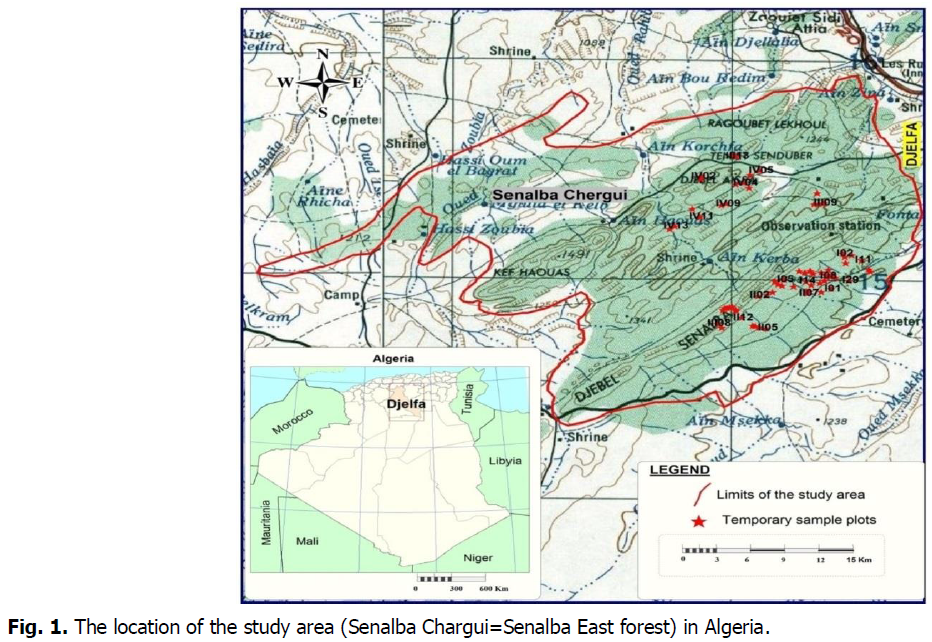
Fig 1: The location of the study area (Senalba Chargui=Senalba East forest) in Algeria.
Sampling
The sampling adopted in this work is stratified and subjective. Stratified sampling makes it possible to obtain representative stations for the various existing ecological situations. We divided our study area into 04 stations according to the massif, the slope exposure and the type of the soil; and for every station, temporary observation plots are installed through subjective sampling, this method is used to study heterogeneous ecological environments (Table 1).
| Station | Number of sample plots | Massif | Slope exposure | Location | Geographic coordinates |
|---|---|---|---|---|---|
| ST01 | 29 | Senalba Chargui | South | Mazreb ElaliSud | 3,181167° 34,65608° 1294 m |
| ST02 | 13 | Senalba Chargui | South | Elbeida | 3,152567° 34,64147° 1358 m |
| ST03 | 14 | Senalba Chargui | North | Mazreb Elali Nord | 3,13125° 34,6284° 1391 m |
| ST04 | 14 | Senalba Chargui | North | Nakazia | 3,13812° 34,6859° 1239 m |
Table 1. Geographic characteristics for each study station.
We have installed in our study stations seventy (70) temporary plots (Table 1). The temporary sample plot is a circular sampling unit that covers an area of 400 m2, and they have been delimited horizontally with a tape measure, and have been identified by the geographical coordinates of its centers.
Choice of indicators
a) Regeneration index
The indicator used for the Aleppo pine regeneration phenomenon is the regeneration index, this index is the number of seedlings per square meter. Considering that the regeneration of Aleppo pine in semi-arid zones is episodic (irregularity and variability of precipitation),we considered as juveniles all the pines with their DBH (Diameter at Breast Height) less than 10 cm (Sarmoum et al., 2020; Dobrowolska and Veblen, 2008); after the evaluation of this indicator in each plot, we classified them according to their numbers and their heights (Table 2).
| Classes by number | Classes by height | ||
|---|---|---|---|
| None | 0 | 01 | Seedling |
| Low | 1-5 | 02 | 25 cm |
| Average | 6-10 | 03 | 25-50 cm |
| Good | 11-20 | 04 | 0.5-1 m |
| Very good | >21 | 05 | 1-2 m |
| 06 | m | ||
Table 2. Classification of pine juveniles (number and height).
b) Dendrometric parameters
In each plot, dendrometric variables were measured: diameter at breast height, total tree height, dominant height, average density per hectare,basal area per hectare, the age of stands, and cumulative surface of crown cover.
c) Phytoecological parameters
The phytoecological study reflects the combination, or the relationships between vegetation and ecological factors, which play an active role in their distribution and development. There are three phases of the study;the first is to determine the types of vegetation, then to identify the active factors of the environment,and the last one to identify species-factor links (Kadik and Godron, 2004). In each plot, a phytoecological survey was carried out to determine the environmental parameters, such as altitude, exposure,slope and lithology.
We used the principal component analysis (PCA) and the hierarchical ascending classification (HAC) to identify the homogeneous sample plots (compared to the regeneration). It should be noted that all statistical analyses (descriptive statistics, the correlation coefficient and the analysis of variance) were made with “Statistica 8”, and the geographical data was mapped using the software “MapInfo 11”.
Results and Discussion
Aleppo pine regeneration is low to zero in more than 54% of the plots studied (Fig. 2), and it is average in more than 15% of the plots and only 30% of plots where the regeneration is very good to good with rates respectively equal to 21.42% and 8.57%. The regeneration index varies between 0.0 to 0.23 plants per square meter,with a mean value equal to 0.036 plants/m2. These values are comparatively lower than reported for Northern Greece stands (Tsakaldimi et al., 2004; Tsitsoni and zagas, 1995) which have found densities from 0.03 to 1.44 seedlings/m2, and in stands subjected to fire (Tsitsoni, 1997; Trabaud et al., 1985) have found that Pinus halepensis seedling density ranged from 01 to 14 seedlings/m2 a few years post-fire.
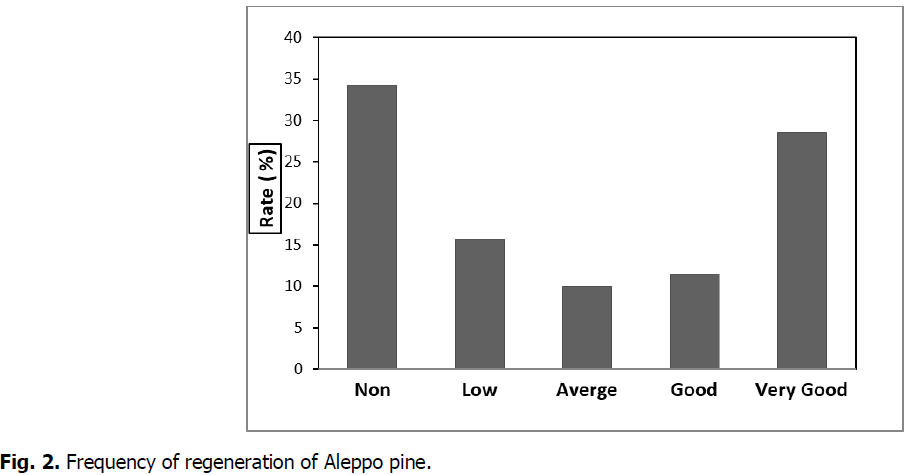
Fig 2: Frequency of regeneration of Aleppo pine.
The analysis of the Frequency of regeneration of Aleppo pine by height (Fig. 3.) shows that:
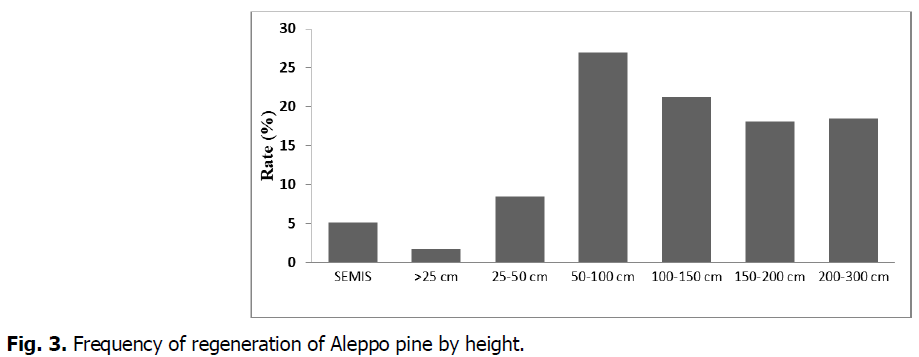
Fig 3: Frequency of regeneration of Aleppo pine by height.
• More than 87% of the plots have no seedlings and 11% have seedlings between one and four, only one plot with a high seedling value equal to 32.
• 10% of the studied plots have seedlings of 25cm, and more than 25% of all the plots have seedlings of 50cm.
• More than 41% of the plots have seedlings of 50-100cm with a number varies between one and fifty seedlings; and between one and eighteen seedlings of 100-150cm are found in more than 42% of the plots.
• More than 38% of the plots have seedlings of 150cm to 200cm and seedlings from 200cm to 300cm are found in 30% of the plots studied.
• More than 67% of the juveniles have a height between 100 cm and 300 cm; This percentage allows us to deduce that these regenerations are old, from 15 to 25 years or more; However, only 7% of the plants are less than 50 cm high, coming from recent regeneration (less than 5 years old) (Table 3).
| Stands | Mean ± standard deviation |
|---|---|
| Density per hectare | 368.93 ± 428.42 |
| Average total height(Htm) | 10.26 ± 1.75 |
| Dominant height (Hd) | 11.949 ± 2.07 |
| Basal area per hectare | 19.907 ± 11.9 |
| cumulative surface of crown cover/400m2 | 153.14 ± 114.43 |
| Regeneration (Density/Ha) | 361.79 ± 477.13 |
| Regeneration index | 0.036 ± 0.048 |
Table 3. Dendrometric characteristics of the stands in plots studied.
Impact of dendrometric factors
The principal component analysis (PCA) executed for total dendrometric variables (the age of stands, the basal area per hectare,the cumulative surface of crown cover, the average density per hectare, total tree height, and the dominant height)allowed us to identify two groups of plots according to the regeneration of Aleppo pine (Fig. 4 and Fig. 5). On the axis "1", the basal area per hectare, the adult crown cover rate and the density per hectare (number of adult Aleppo pine trees per hectare) are opposed on the negative side, and on the positive side the regeneration index, the average stand age, the average total height and the dominant height. On the factorial plane (1 X 2), the representation quality is superior to 68% inertia (37.77%+30.76%) which gives two groups of plots in relation to Aleppo pine regeneration: a highly significant regeneration on the positive side (G1) and a low to no regeneration density on the negative side (G2).
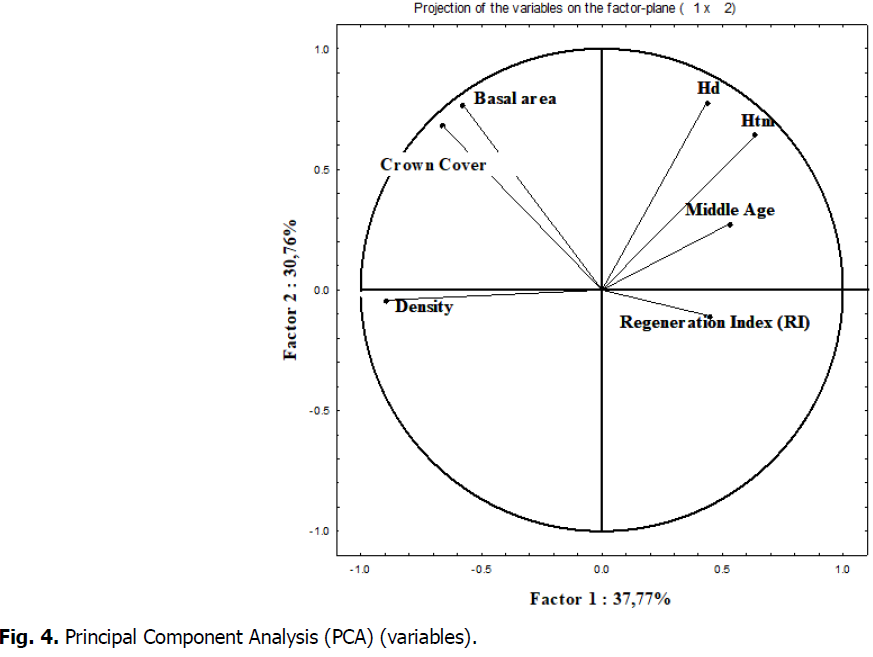
Fig 4: Principal Component Analysis (PCA) (variables).
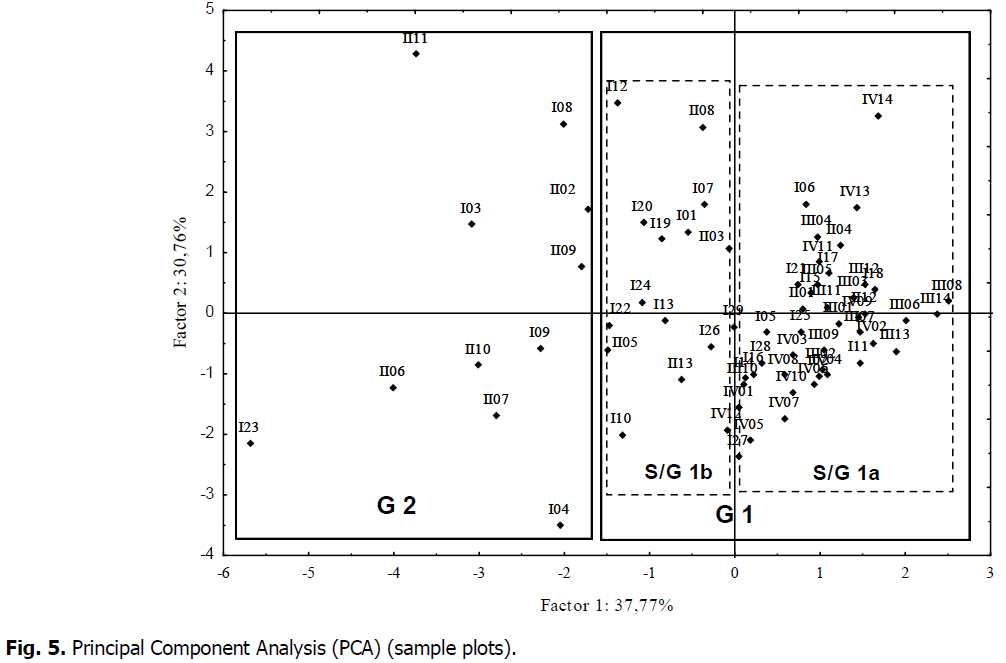
Fig 5: Principal Component Analysis (PCA) (sample plots).
The ascending hierarchical classification (AHC) (Fig. 6) has identified and confirmed the two groups of variables demonstrated by the PCA.
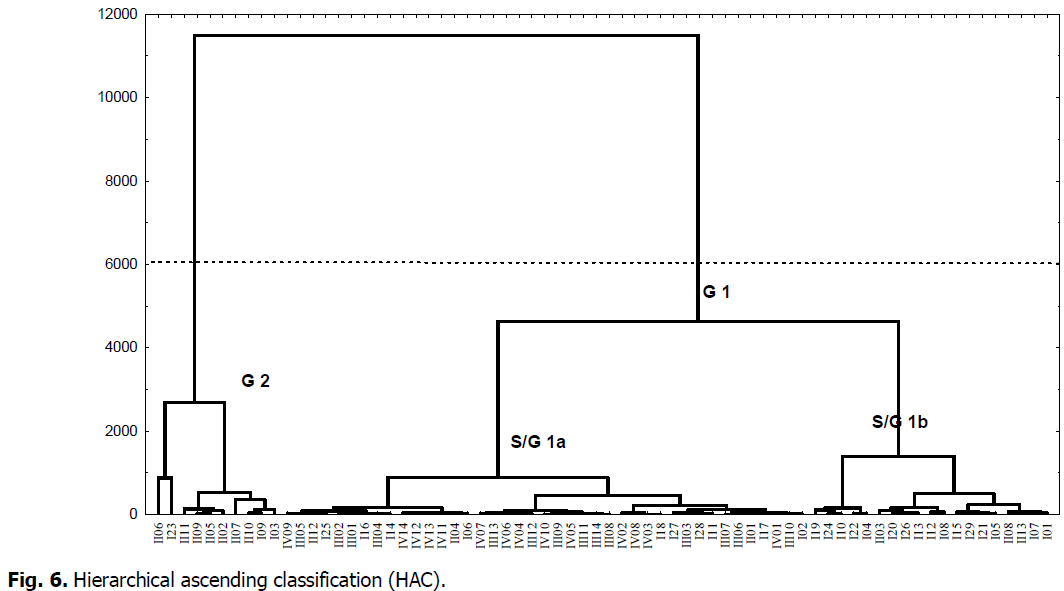
Fig 6: Hierarchical ascending classification (HAC).
Group G1 divided in two subgroups (S/G1a and S/G1b)
1) S/G1a composed by 39 plots where the majority of plots are from the station III (14 plots) and the station IV (14 plots); this subgroup has a significant correlation with the variables:the average stand age, the average total height and the dominant height; the regeneration index reached a maximum equal 0.2325 seedlings/m2. However, it shows weak dendrometric values regarding: basal area/hectare (between 09 m2/h and 24 m2/h), crown cover (15%-40%) and density per hectare (50 trees/hectare-200 trees/hectare), these weaknesses could be explained as follows:
Station III: It is located on a slope with a northern exposure, on a steep gradient (up to 70%) and on a marly-limestone geological substratum, mostly gypsum, which makes it more vulnerable to the phenomenon of wind-throw.
Station IV: It is based on a geological sandstone substrate characterized by a high coverage of rocky outcrops (sometimes more than 50%) where the Aleppo pine, Juniperus phoenicea and Pistacia lentiscus exploited the smallest interstices.
2) S/G1b includes 20 plots, mainly from station I, where the dendrometric parameters of Aleppo pine stands are average and the regeneration index is low, it is less than 0.08 plantlets/m2 and zero in 50% of the plots.
Group G2 composed by 11 plots (I03, I08, I9, I23, II02, II05, II06, II07, II09, II10 and II11) highly correlated with the following variables: basal area/hectare (24 m2/h-71 m2/h), crown cover rate (55%-132%) and density per hectare (400 trees/hectare-2575 trees/hectare); with the almost total absence of the regeneration of Aleppo pine in this group. These plots are frequently found in stations I and in station II which are installed on the south slope, characterized by a calcareous soil.
Age of stands
The stands most represented in our sampling are in the age group between 80 and 120 years with a rate of 45% of all the plots studied (Fig. 7) and followed by older stands, over 120 years old and can reach more than 180 years with a rate of 37%; The least represented stand (<2%) is where the age is between 30-40 years.
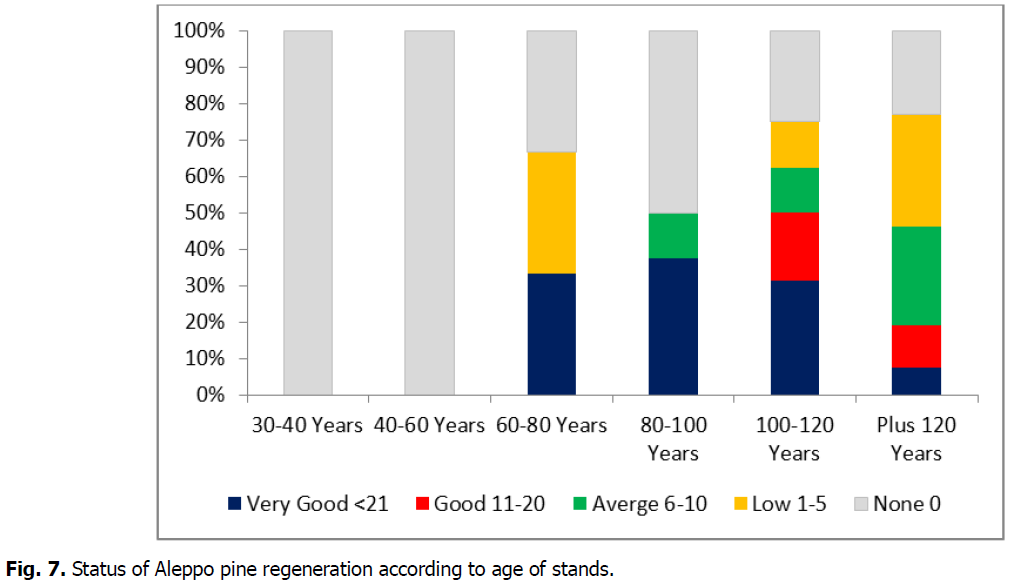
Fig 7: Status of Aleppo pine regeneration according to age of stands.
The analysis of variance (ANOVA) confirms that there is an impact of stand age on Aleppo pine regeneration, with a significant difference between the age classes, where the age class from 80 to 120 years has the highest regeneration indices (Fig. 8) is collected over 86% of the plots where the regeneration is very goodand 50% of the class of good regeneration; contrary to the oldest stands (over 120 years) where more than 61% of the plots have low regeneration, this is explained by the low productivity of the seeds, Neveux et al., (1986)indicated that the fertility of Aleppo pine decreasing after 60/70 years.
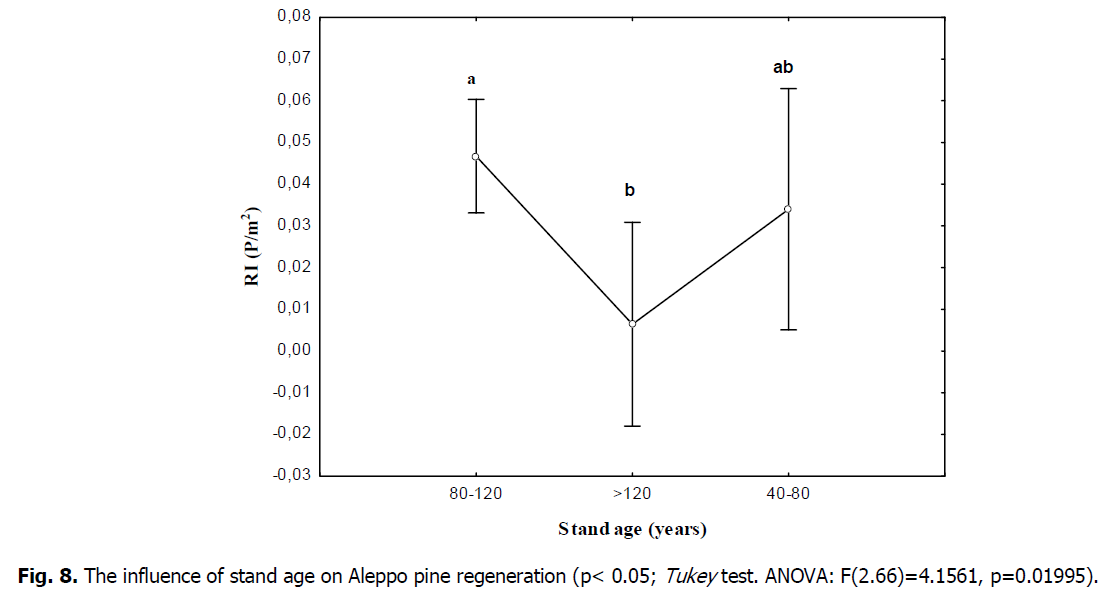
Fig 8: The influence of stand age on Aleppo pine regeneration (p< 0.05; Tukey test. ANOVA: F(2.66)=4.1561, p=0.01995).
Density of trees
The density is the number of adult trees per hectare, it varies in the plots studied between 50 trees/ha and 2575 trees/ha with an average of 369 trees/ha; it is negatively proportional to the regeneration of Aleppo pine with a correlation coefficient equal to-0.33.
The analysis of variance shows that there is a significant difference between density classes, and the highest regeneration is observed in stands with a density between 100 and 250 trees/ha (Fig. 9).
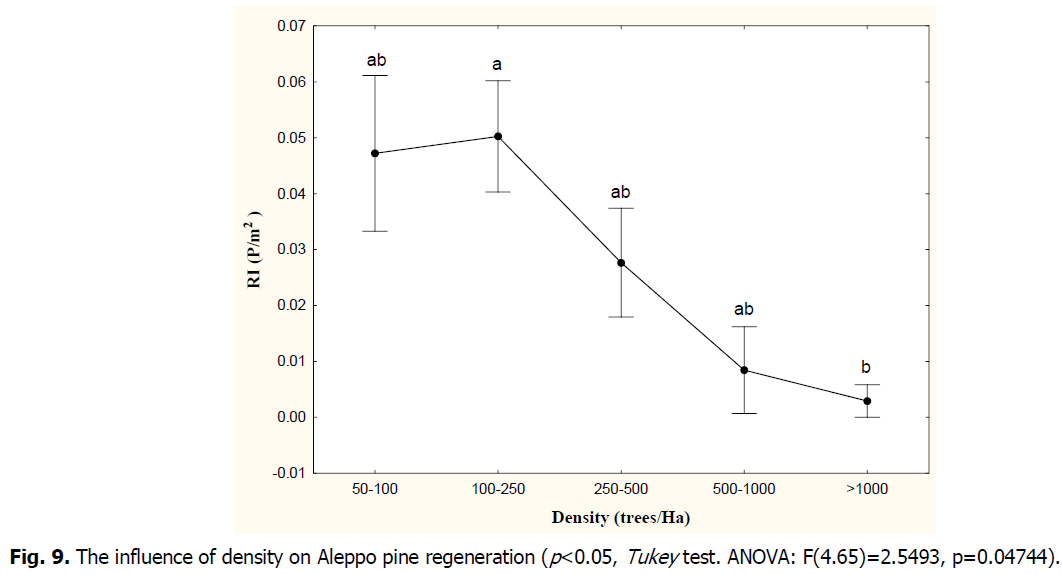
Fig 9: The influence of density on Aleppo pine regeneration (p<0.05, Tukey test. ANOVA: F(4.65)=2.5493, p=0.04744).
Basal area
The basal area varies between 2.75 m2/Ha and 70.62 m2/Ha with an average of 19.9 m2/Ha. The regeneration of the Aleppo pine represented by the regeneration index is inversely proportional to the basal area (r=-0.25). The analysis of variance shows that basal area has a significant influence on regeneration, the regeneration index reaches its maximum in the stands where basal area does not exceed 10 to 20 m2/ha (Fig. 10).
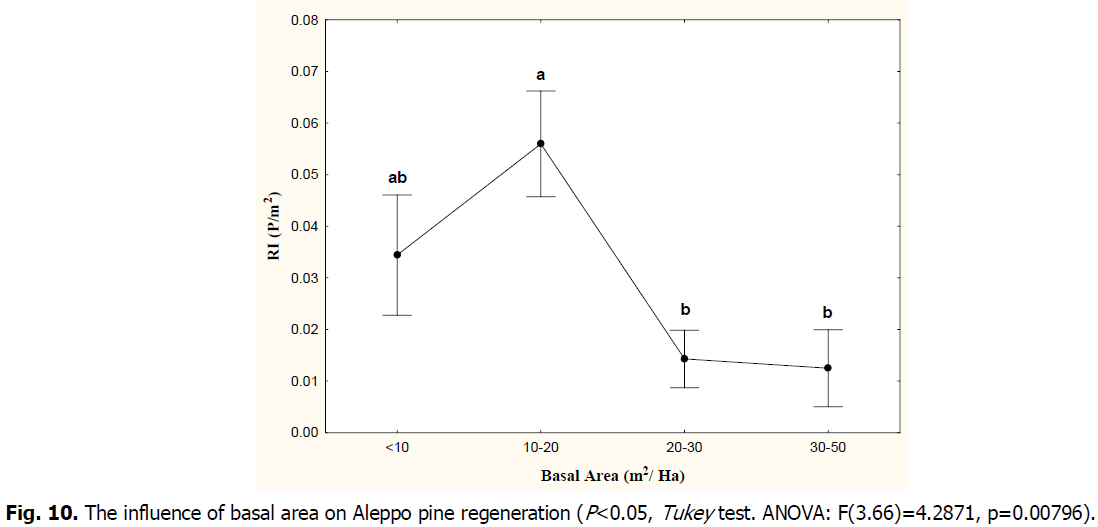
Fig 10: The influence of basal area on Aleppo pine regeneration (P<0.05, Tukey test. ANOVA: F(3.66)=4.2871, p=0.00796).
Crown cover
The projection of the cumulative surface of the crowns of adult trees in the studied plots varies between 29.8 m2 and 515.6 m2 and a cover rate from 7.45% to 128.9%, with an average of 153.14 m2 (38.3%); a high recovery rate by the crowns of adult trees has a negative effect on the regeneration of Aleppo pine (“correlation coefficient” r=-0.23); under a closed stand, seedling density is low due to reduced light availability and increased litter thickness (Stein and Kimberling, 2003). Hikmat et al., (1984) confirmed that the natural regeneration of Aleppo pine and the growth of seedlings are inversely proportional to the tree cover in the plots. The tree cover and the shrub cover significantly affectthe regeneration emergence or failure (Tsakaldimi et al., 2004); it does not allow light or rainfall to reach forest soil (Ganatsas, 1993). The analysis of variance (Fig. 11) shows that the regeneration reaches its maximum with an Aleppo pine crown cover rate ranging from 25 to 50%; this result is in accordance with that given by (Tsakaldimi et al., 2004) in northern Greece; (Vickers and Palmer, 2000) have also found that the density of Pinus sylvestris seedlings is clearly linked to the crown cover by a quadratic relationship.
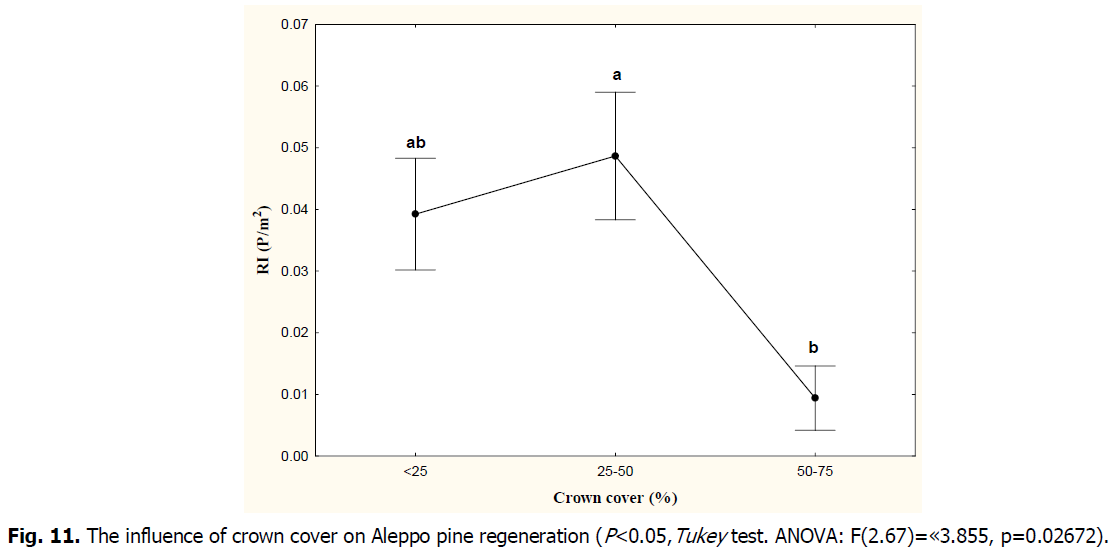
Fig 11: The influence of crown cover on Aleppo pine regeneration (P<0.05,Tukey test. ANOVA: F(2.67)=«3.855, p=0.02672).
Impact of orographic factors
Stations
On the four sampled stations, the analysis of variance shows significantly that the best regeneration of Aleppo pine is represented in the station III, which is located in the ubac of the massif, on a marly-calcareous soil mostly gypsum, the Aleppo pine is codominated with the Oxycedre Juniper and Rosemary. While, the station IV shows the lowest rate of regeneration. It is characterized by a sandstone substrate with the presence of a high rate of outcrop of the bedrock; the main underbrush species in this station are Phoenician Juniper and (Stipa tenacissima) (Fig. 12). These results are in the same direction as those of (Sarmoum et al., 2020; Sarmoum et al., 1916), which shows that Aleppo pine stands on sandstone substrate are more sensitive to climatic hazards and changes than those on limestone or marlstone soil.
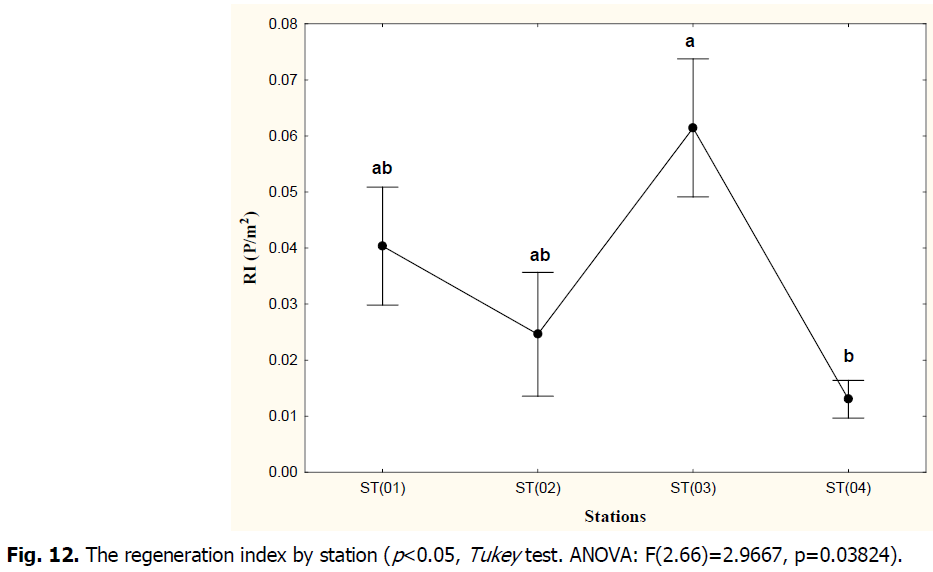
Fig 12: The regeneration index by station (p<0.05, Tukey test. ANOVA: F(2.66)=2.9667, p=0.03824).
Altitude
The studied plots are characterized by an altitudinal slice of 1184 m to 1450 m, the analysis of variance shows that altitude significantly affects the regeneration of Aleppo pine (Fig. 13); in particular, the altitudinal interval from 1350 to 1450 m includes the highest regeneration index of Aleppo pine.
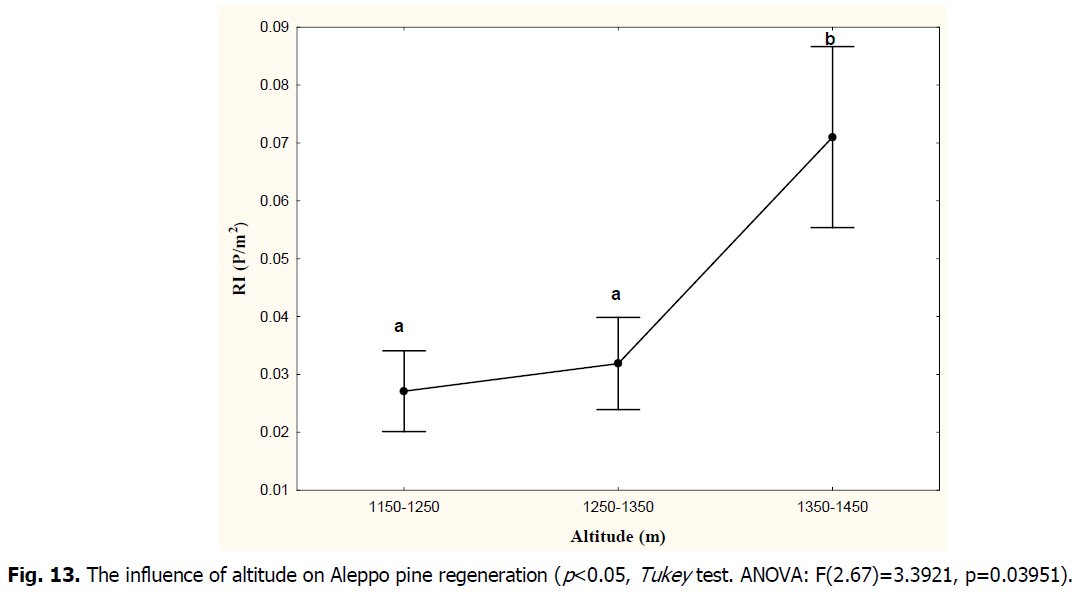
Fig 13: The influence of altitude on Aleppo pine regeneration (p<0.05, Tukey test. ANOVA: F(2.67)=3.3921, p=0.03951).
Slope exposure
The statistical analysis (Table 4) shows that The northern "ubac" slope of Senalba Chargui represents the best regenerations of Aleppo pine with a rate of over 45% where the regeneration has been good to very good, and 30.9% of the plots have low or no regeneration; on the contrary, the southern slope "adret" represents more than 61% of the plots have low or no regeneration, and only 23.4% where the regeneration was good to very good;And this may explain that the northern slope is cooler and sheltered from the influences of the south, Kadik (1983) observed in the same massif (Senalba Chargui) that the temperature differences between the North and South slopes can exceed 8°C, and the difference between the two exposures is accentuated during the cold period of the year from October to April, and it is unimportant during the dry period.
| Tukey HSD test; variable index regeneration Homogenous Groups, alpha=0.05000 Error: Between MS=0.00217, df=68,000 |
||||
|---|---|---|---|---|
| Slope Exposure | Index Regeneration-Mean | 1 | 2 | |
| 1 | South | 0.027772 | **** | |
| 2 | North | 0.052292 | **** | |
Table 4. The influence of slope exposure on Aleppo pine regeneration.
Conclusion
The objective of our work was to analyze the effects of dendrometric and orographic parameters on the natural regeneration of Aleppo pine(Pinus halepensis) in the forest massif of Senalba Chargui (Djelfa in Algeria) characterized by in a semi-arid climatein the massif forest of Senalba Chargui (Djelfa, Algeria). The regeneration index varies between 0 and 0.23 seedlings/m2, and 60% of the plots studied have low or no regeneration. The microclimate, provided by the northern slope, is more favorable to the regeneration of Aleppo pine compared to the circumstances of the southern slope. Regeneration was decreased with the magnitude of stand attributes, including age, density, basal area and crown projection area; indeed, the regeneration of Aleppo pine is successful in an open environment (not smothered) and supported by trees in vigorous condition and an age between 60 to 100 years. The highest regeneration index of Aleppo pine has been observed in stands with a crown cover of 25 and 50%, a basal area not exceeded 10 to 20 m2/ha, a density between 100 to 250 trees/ha, northern slope, and altitudinal from 1350 to 1450 m.
References
Arianoutsou, M., Ne’eman, G. (2000). Post-fire regeneration of natural Pinus halepensis forests in the east Mediterranean Basin. Ecology, Biogeography and Management of Pinus halepensis and P. brutia forest ecosystems in the Mediterranean Basin. Backhuys Publishers, Leiden, The Netherlands, pp:269-290.
Google Scholar, Crossref, Indexed at
Badot, P.M., Garrec, J.P. (1993). Dépérissement local du pin d'Alep (Pinus halepensis) le long du littoral méditerranéen. Revue Forestière Française, 45:134-140.
Google Scholar, Crossref, Indexed at
Bentouati, A., Oudjehih, B., Alatou, D. (2005). Croissance en hauteur dominante et classes de ferilite du pin d’alep (pinus halepensis mill.) dans le massif de ouled-yakoub et des benioudjana (khenchela-aures). Sciences and Technologie. C, Biotechnologies, pp:57-62.
Boudy, P. (1950). Économie forestière nord-africaine: II. Monographie et traitement des essences forestières. Larose, Paris.
Calama, R., Montero, G. (2007). Cone and seed production from stone pine (Pinus pinea L.) stands in Central Range (Spain). European Journal of Forest Research, 126:23-35.
Google Scholar, Crossref, Indexed at
Chakali, G. (2008). Biology and behaviour of the bark beetle, Tomicus destruens (Wollaston, 1865) (Coleoptera: Scolytidae) in Alepo pine of Algeria.
Dahmani, M.M. (2018). État des connaissances sur les systèmes forestiers d’Algérie/State of knowledge on forestsystems in Algeria. Ecologia Mediterranea, 44:111-117.
Deroueche, H. (2015). Télédétection et analyse des dépérissements des forêts Naturelles en zone semi-aride (Djelfa).
Dobrowolska, D., Veblen, T.T. (2008). Treefall-gap structure and regeneration in mixed Abies alba stands in central Poland. Forest Ecology and Management, 255:3469-3476.
Google Scholar, Crossref, Indexed at
Emberger, L. (1971). Travaux de botanique et d’écologie. Éd, Masson et Cies, France.
Ganatsas, P. (1993). Stand structure and natural regeneration of spruce forest in Elatia Drama, Northern Greece. Aristotle University of Thessaloniki, Department of Forestry and Natural Environment, Greece.
Guit, B., Nedjimi, B., Chakali, G., Guibal, F. (2016). État sanitaire des peuplements de Pin d’Alep (Pinus halepensis Mill.) dans le massif forestier de Senalba (Djelfa, Algérie). Revue d'Ecologie, Terre et Vie, 71:156-167.
Hikmat, A., Barbero, M., Loisel R. (1984). Réflexions sur le dynamisme actuel de la régénération naturelle du pin d’Alep (Pinus halepensis Mill.) dans les pinèdes incendiées en Provence calcaire (de 1973 à 1979). Ecologia Mediterranea, 10:85-104.
Hikmat, A., Barbero, M., Loisel, R., Quezel, P. (1985). Les forêts de pin d'Alep dans le Sud-Est méditerranéen français. Analyses Economiques. 1ère partie. Forêt Méditerranéenne, 7:35-42.
Kadik, A.L. (2005). Étude phytosociologique et phytoécologique des formations à pin d’Alep (Pinus halepensis Mill.) de l’étage bioclimatique semi-aride Algérien. USTHB, Algerie.
Kadik, B. (1983). Contribution à l'étude du Pin d'Alep (Pinus halepensis Mill.) en Algérie : écologie, dendrométrie et morphologie. Faculté Aix-Marseille III, France.
Kadik, L., Godron, M. (2004). Contribution à la dégradation dans les pineraies de Pinus halepensis Mill. Journal Botanique de France, 27:9-19.
Kazanis, D., Arianoutsou, M. (2004). Long-term post-fire vegetation dynamics in Pinus halepensis forests of Central Greece: a functional group approach. Plant Ecology, 171:101-121.
Google Scholar, Crossref, Indexed at
Louni, D. (1994). Les forêts algériennes. Forêt Méditerranéenne, 15:59-63.
Madoui, A. (2018). Les incendies de forêts en Algérie: 7tude de l’évolution après feu des peuplements de Pinus halepensis Mill. dans l’Est algérien.Cas de la Forêt de Bou-Taleb, du Reboisement de Zenadia et du Parc National d’el Kala.
Madoui, A., Géhu, J.M., Alatou, D. (2006). L’effet du feu sur la composition des pinèdes de Pinus halepensis Mill. dans le nord de la forêt de Bou-Taleb, Algérie. Ecologia Mediterranea, 32:5-13.
Médail, F., Diadema, K. (2006). Biodiversité végétale méditerranéenne et anthropisation: approches macro et micro-régionales. In Annales de Géographie, Armand Colin, pp:618-640.
Moravec, J. (1990). Regeneration of NW African Pinus halepensis forests following fire. Vegetation, 87:29-36.
Nahal, I. (1962). Le Pin d'Alep (Fines halepensis Mill.). Étude taxonomique, phytogéographique, écologique et sylvicole. Annales de l'Ecole Nationale des Eaux et Forêts et de la Station de Recherches et Expériences Forestières, 19:477-688.
Neveux, M., Duhen, L.M., Corti, J.M., Devallois, P., Fontanel, J.L., Boiseau, P. (1986). Plaidoyer pour une sylviculture du Pin d'Alep par les techniciens de terrain. Forêt Méditerranéenne, 8:13-18.
Quezel, P., Barbero, M. (1992). Le pin d'Alep et les espèces voisines: répartition et caractères écologiques généraux, sa dynamique récente en France méditerranéenne. Forêt Méditerranéenne, 13:158-170.
Quezel, P., Barbero, M., Loisel, R. (1990). Les reboisements en région méditerranéenne. Incidences biologiques et économiques. Forêt Méditerranéenne, 12:103-114.
Sarmoum, M., Guibal, F., Abdoun, F. (2016). Effet des facteurs stationnels sur la croissance radiale et la réponse du pin d’Alep au climat dans le massif de l’Ouarsenis, Algérie. Bois et Forêts des Tropiques, 329:17-27.
Sarmoum, M., Navarro-Cirrillo, R., Guibal, F., Abdoun, F. (2020). Typology, productivity and dynamics of aleppo pine stands in the ouarsenis massif (Algeria). Agro Forestry.
Spanos, I.A., Daskalakou, E.N., Thanos, C.A. (2000). Postfire, natural regeneration of Pinus brutia forests in Thasos island, Greece. Acta Oecologica, 21:13-20.
Stein, S.J., Kimberling, D.N. (2003). Germination, establishment, and mortality of naturally seeded southwestern ponderosa pine. Western Journal of Applied Forestry, 18:109-114.
Thanos, C.Á. (2000). Ecophysiology of seed germination éí pinus halepensis and ñ. brutia.
Trabaud, L., Michels, C., Grosman, J. (1985). Recovery of burnt Pinus halepensis Mill. forests. II. Pine reconstruction after wildfire. Forest Ecology and Management, 13:167-179.
Tsakaldimi, M.N., Tsitsoni, T.K., Zagas, T., Ganatsas, P.P. (2004). Aleppo pine (Pinus halepensis) natural regeneration, without fire, in the Kassandra Peninsula, northern Greece. In Proceeding 10th MEDECOS Conference, pp:1-8.
Tsitsoni, T. (1997). Conditions determining natural regeneration after wildfires in the Pinus halepensis (Miller, 1768) forests of Kassandra Peninsula (North Greece). Forest Ecology and Management, 92:199-208.
Tsitsoni, T., Zagas, T. (1995). Development of Pinus halepensis natural regeneration in Kassandra Chalkidiki. Scientific Annals of the Department of Forestry and Natural Environment, 1:93-103.
Vickers, A.D., Palmer, S.C.F. (2000). The influence of canopy cover and other factors upon the regeneration of Scots pine and its associated ground flora within Glen Tanar National Nature Reserve. Forestry, 73:37-49.
Author Info
B. Daoudi1*, K. Cherifi1, F.A. Belhouadjeb2 and A. Khadoumi32Centre de Recherche en Agropastoralisme (CRAPAST), Djelfa, Algeria
3Laboratoire d’Exploration et valorisation des écosystèmes steppiques (EVES), Faculté des Sciences de la Nature et de la Vie, Université Ziane Achour, Djelfa, Algeria
Citation: Daoudi, B., Cherifi, K., Belhouadjeb, F.A., Khadoumi, A. (2022). Dendrometric and orographic factors influencing the natural regeneration of Aleppo pine (Pinus halepensis Mill.) in semi-arid regions (Djelfa, Algeria). Ukrainian Journal of Ecology. 12:30-42.
Received: 30-Nov-2022, Manuscript No. UJE-22-81881; , Pre QC No. P-81881; Editor assigned: 02-Dec-2022, Pre QC No. P-81881; Reviewed: 15-Dec-2022, QC No. Q-81881; Revised: 21-Dec-2022, Manuscript No. R-81881; Published: 29-Dec-2022, DOI: 10.15421/2022_417
Copyright: This is an open access article distributed under the terms of the Creative Commons Attribution License, which permits unrestricted use, distribution, and reproduction in any medium, provided the original work is properly cited.
